Analyzing Reinforcement Theory for Employee Motivation at David Jones
VerifiedAdded on 2022/08/18
|7
|906
|21
Report
AI Summary
This report provides an overview of the reinforcement theory of motivation, emphasizing how environmental consequences influence human behavior. It explores the theory's relevance to David Jones, an Australian departmental store, and outlines practical strategies for its implementation. The report explains positive and negative reinforcement, highlighting how managers can use these approaches to enhance employee performance and productivity. Strategies discussed include directing employees on tasks through positive reinforcement and implementing constant coercion and control through punishment. The report concludes by emphasizing the importance of rewards and equal treatment to boost employee self-confidence, goal orientation, and overall organizational outcomes. References to supporting literature are also included.
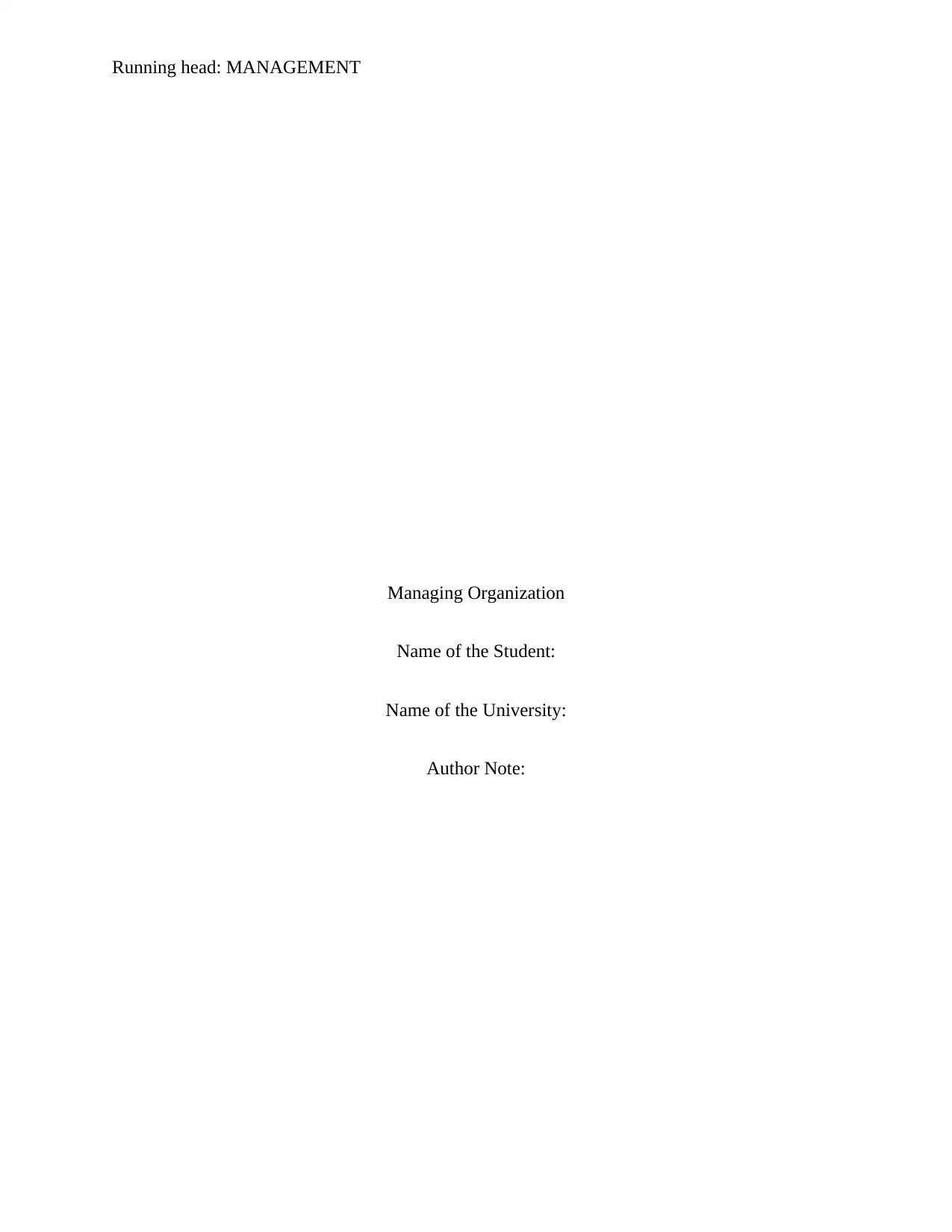
Running head: MANAGEMENT
Managing Organization
Name of the Student:
Name of the University:
Author Note:
Managing Organization
Name of the Student:
Name of the University:
Author Note:
Paraphrase This Document
Need a fresh take? Get an instant paraphrase of this document with our AI Paraphraser
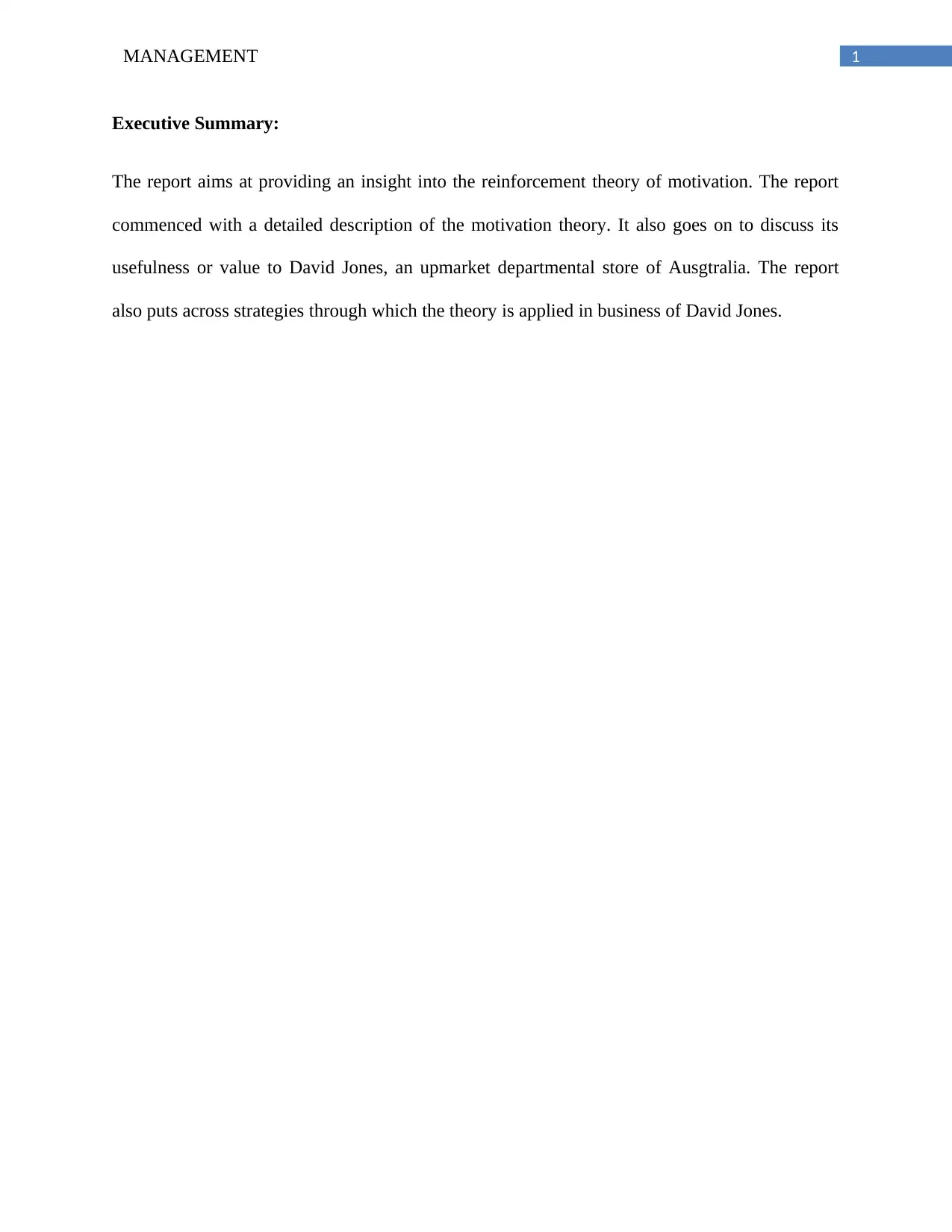
MANAGEMENT 1
Executive Summary:
The report aims at providing an insight into the reinforcement theory of motivation. The report
commenced with a detailed description of the motivation theory. It also goes on to discuss its
usefulness or value to David Jones, an upmarket departmental store of Ausgtralia. The report
also puts across strategies through which the theory is applied in business of David Jones.
Executive Summary:
The report aims at providing an insight into the reinforcement theory of motivation. The report
commenced with a detailed description of the motivation theory. It also goes on to discuss its
usefulness or value to David Jones, an upmarket departmental store of Ausgtralia. The report
also puts across strategies through which the theory is applied in business of David Jones.
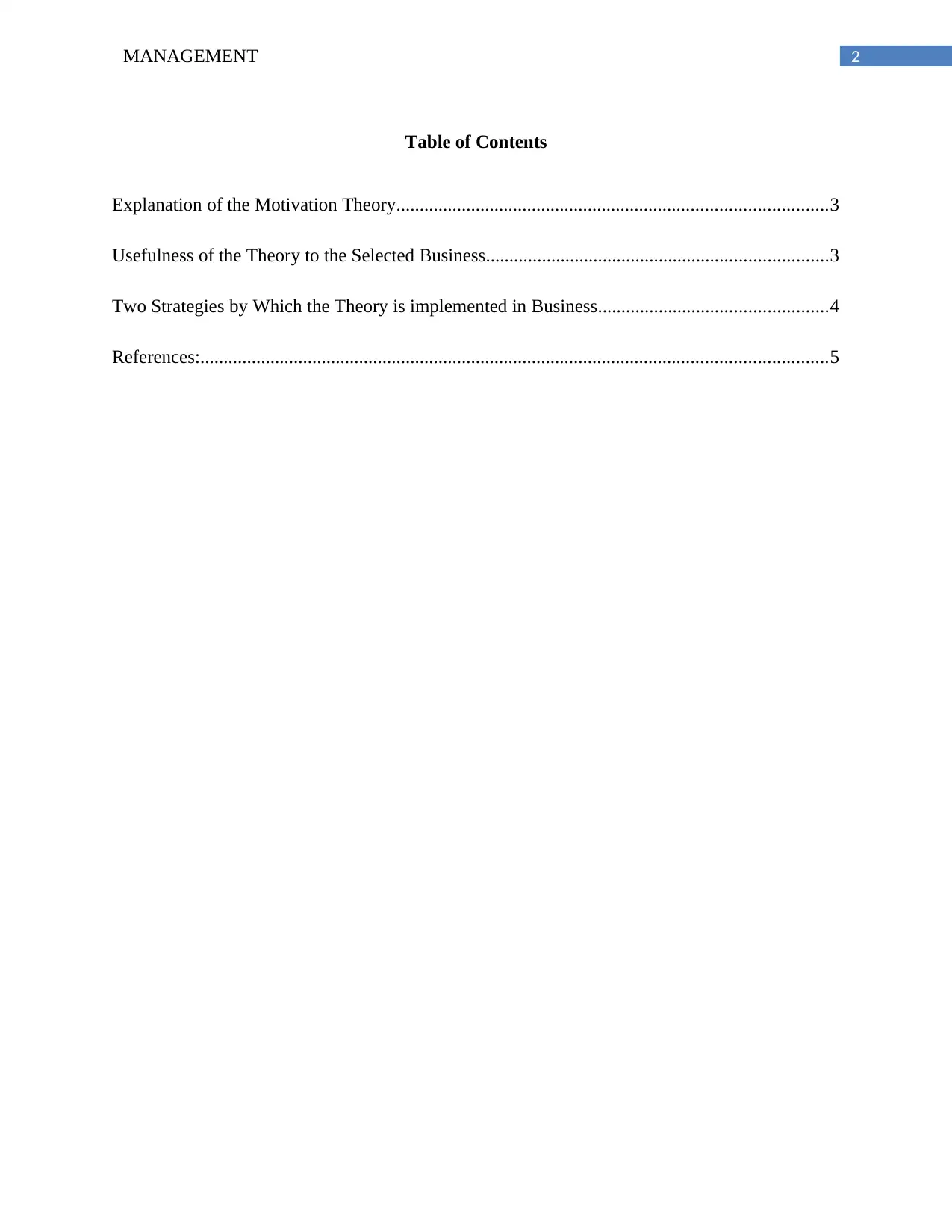
2MANAGEMENT
Table of Contents
Explanation of the Motivation Theory............................................................................................3
Usefulness of the Theory to the Selected Business.........................................................................3
Two Strategies by Which the Theory is implemented in Business.................................................4
References:......................................................................................................................................5
Table of Contents
Explanation of the Motivation Theory............................................................................................3
Usefulness of the Theory to the Selected Business.........................................................................3
Two Strategies by Which the Theory is implemented in Business.................................................4
References:......................................................................................................................................5
⊘ This is a preview!⊘
Do you want full access?
Subscribe today to unlock all pages.

Trusted by 1+ million students worldwide
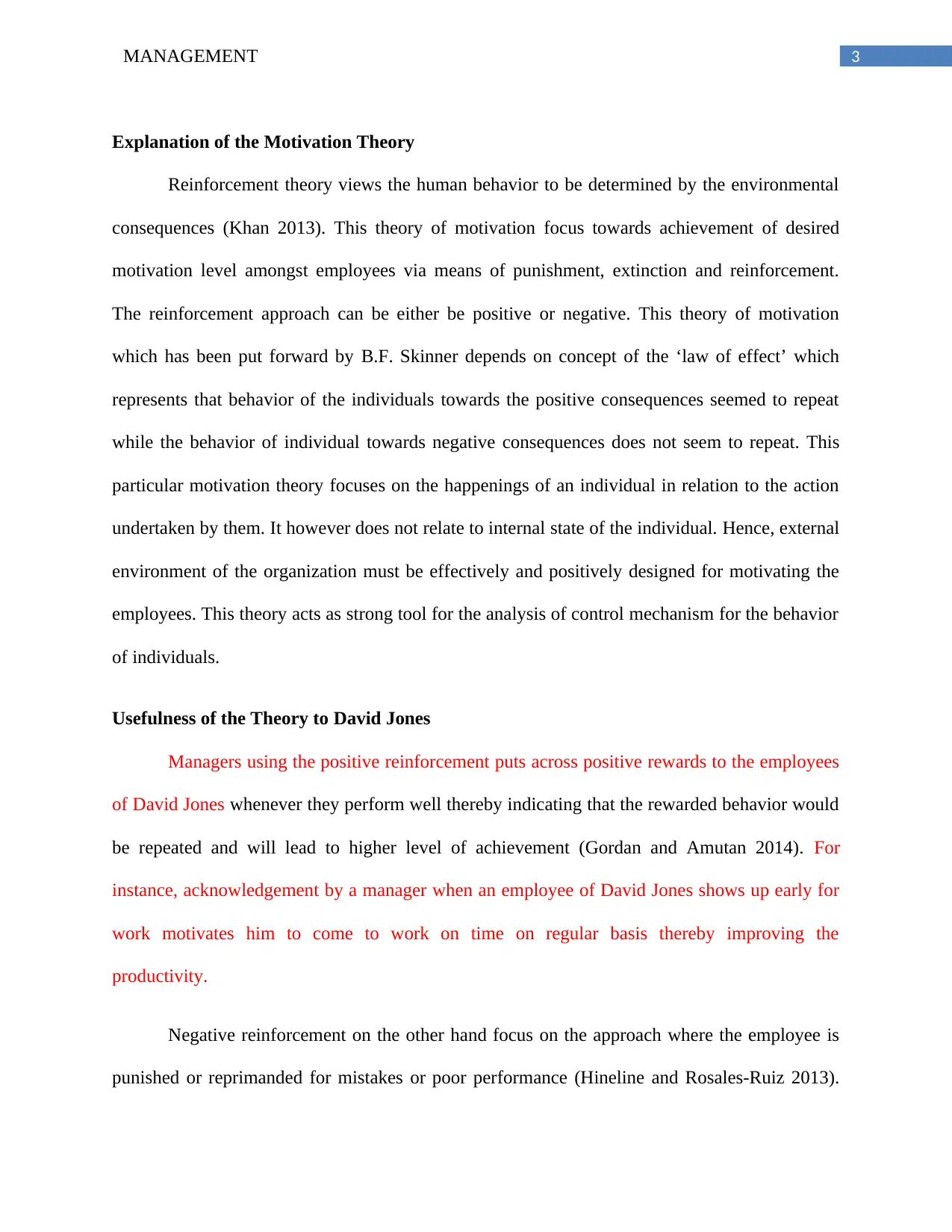
3MANAGEMENT
Explanation of the Motivation Theory
Reinforcement theory views the human behavior to be determined by the environmental
consequences (Khan 2013). This theory of motivation focus towards achievement of desired
motivation level amongst employees via means of punishment, extinction and reinforcement.
The reinforcement approach can be either be positive or negative. This theory of motivation
which has been put forward by B.F. Skinner depends on concept of the ‘law of effect’ which
represents that behavior of the individuals towards the positive consequences seemed to repeat
while the behavior of individual towards negative consequences does not seem to repeat. This
particular motivation theory focuses on the happenings of an individual in relation to the action
undertaken by them. It however does not relate to internal state of the individual. Hence, external
environment of the organization must be effectively and positively designed for motivating the
employees. This theory acts as strong tool for the analysis of control mechanism for the behavior
of individuals.
Usefulness of the Theory to David Jones
Managers using the positive reinforcement puts across positive rewards to the employees
of David Jones whenever they perform well thereby indicating that the rewarded behavior would
be repeated and will lead to higher level of achievement (Gordan and Amutan 2014). For
instance, acknowledgement by a manager when an employee of David Jones shows up early for
work motivates him to come to work on time on regular basis thereby improving the
productivity.
Negative reinforcement on the other hand focus on the approach where the employee is
punished or reprimanded for mistakes or poor performance (Hineline and Rosales-Ruiz 2013).
Explanation of the Motivation Theory
Reinforcement theory views the human behavior to be determined by the environmental
consequences (Khan 2013). This theory of motivation focus towards achievement of desired
motivation level amongst employees via means of punishment, extinction and reinforcement.
The reinforcement approach can be either be positive or negative. This theory of motivation
which has been put forward by B.F. Skinner depends on concept of the ‘law of effect’ which
represents that behavior of the individuals towards the positive consequences seemed to repeat
while the behavior of individual towards negative consequences does not seem to repeat. This
particular motivation theory focuses on the happenings of an individual in relation to the action
undertaken by them. It however does not relate to internal state of the individual. Hence, external
environment of the organization must be effectively and positively designed for motivating the
employees. This theory acts as strong tool for the analysis of control mechanism for the behavior
of individuals.
Usefulness of the Theory to David Jones
Managers using the positive reinforcement puts across positive rewards to the employees
of David Jones whenever they perform well thereby indicating that the rewarded behavior would
be repeated and will lead to higher level of achievement (Gordan and Amutan 2014). For
instance, acknowledgement by a manager when an employee of David Jones shows up early for
work motivates him to come to work on time on regular basis thereby improving the
productivity.
Negative reinforcement on the other hand focus on the approach where the employee is
punished or reprimanded for mistakes or poor performance (Hineline and Rosales-Ruiz 2013).
Paraphrase This Document
Need a fresh take? Get an instant paraphrase of this document with our AI Paraphraser
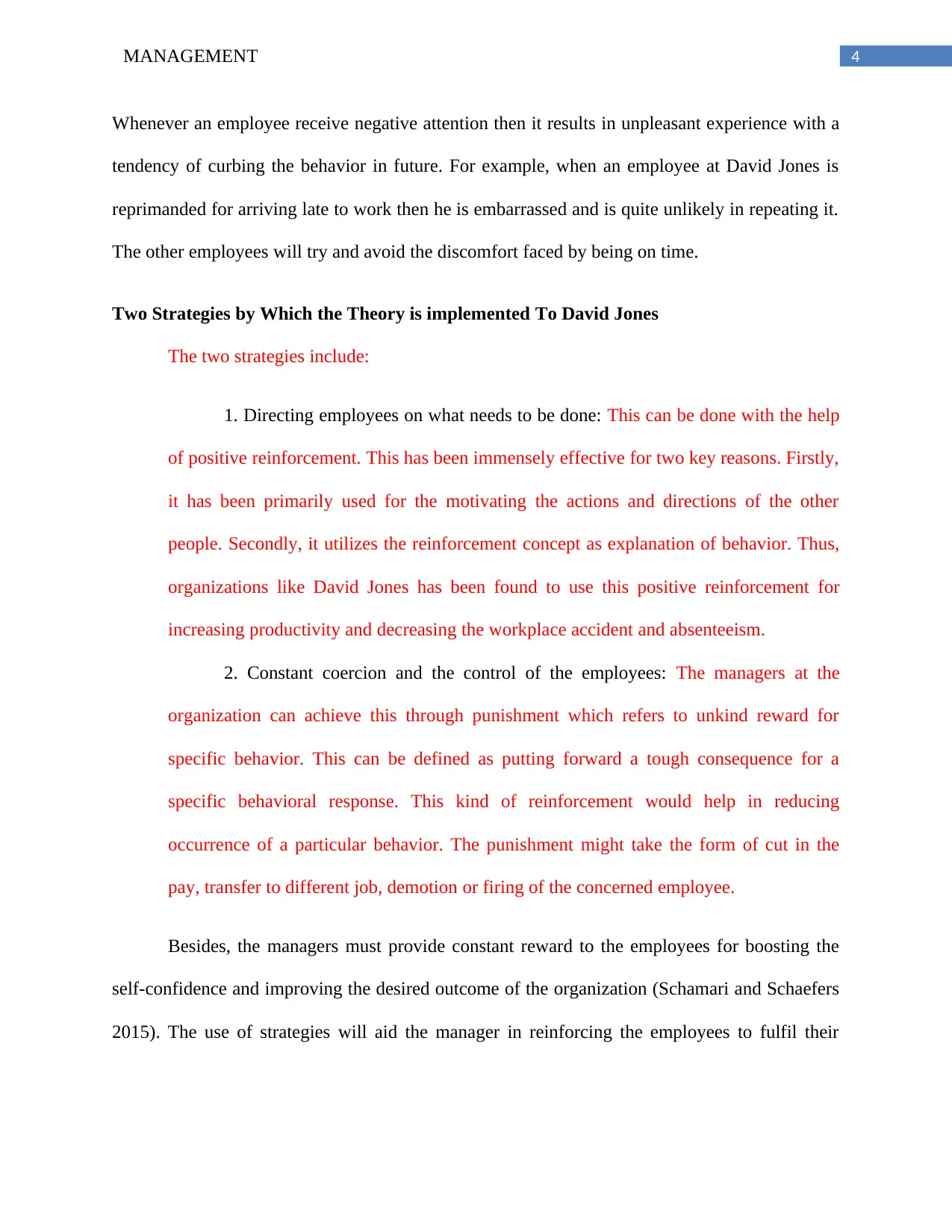
4MANAGEMENT
Whenever an employee receive negative attention then it results in unpleasant experience with a
tendency of curbing the behavior in future. For example, when an employee at David Jones is
reprimanded for arriving late to work then he is embarrassed and is quite unlikely in repeating it.
The other employees will try and avoid the discomfort faced by being on time.
Two Strategies by Which the Theory is implemented To David Jones
The two strategies include:
1. Directing employees on what needs to be done: This can be done with the help
of positive reinforcement. This has been immensely effective for two key reasons. Firstly,
it has been primarily used for the motivating the actions and directions of the other
people. Secondly, it utilizes the reinforcement concept as explanation of behavior. Thus,
organizations like David Jones has been found to use this positive reinforcement for
increasing productivity and decreasing the workplace accident and absenteeism.
2. Constant coercion and the control of the employees: The managers at the
organization can achieve this through punishment which refers to unkind reward for
specific behavior. This can be defined as putting forward a tough consequence for a
specific behavioral response. This kind of reinforcement would help in reducing
occurrence of a particular behavior. The punishment might take the form of cut in the
pay, transfer to different job, demotion or firing of the concerned employee.
Besides, the managers must provide constant reward to the employees for boosting the
self-confidence and improving the desired outcome of the organization (Schamari and Schaefers
2015). The use of strategies will aid the manager in reinforcing the employees to fulfil their
Whenever an employee receive negative attention then it results in unpleasant experience with a
tendency of curbing the behavior in future. For example, when an employee at David Jones is
reprimanded for arriving late to work then he is embarrassed and is quite unlikely in repeating it.
The other employees will try and avoid the discomfort faced by being on time.
Two Strategies by Which the Theory is implemented To David Jones
The two strategies include:
1. Directing employees on what needs to be done: This can be done with the help
of positive reinforcement. This has been immensely effective for two key reasons. Firstly,
it has been primarily used for the motivating the actions and directions of the other
people. Secondly, it utilizes the reinforcement concept as explanation of behavior. Thus,
organizations like David Jones has been found to use this positive reinforcement for
increasing productivity and decreasing the workplace accident and absenteeism.
2. Constant coercion and the control of the employees: The managers at the
organization can achieve this through punishment which refers to unkind reward for
specific behavior. This can be defined as putting forward a tough consequence for a
specific behavioral response. This kind of reinforcement would help in reducing
occurrence of a particular behavior. The punishment might take the form of cut in the
pay, transfer to different job, demotion or firing of the concerned employee.
Besides, the managers must provide constant reward to the employees for boosting the
self-confidence and improving the desired outcome of the organization (Schamari and Schaefers
2015). The use of strategies will aid the manager in reinforcing the employees to fulfil their
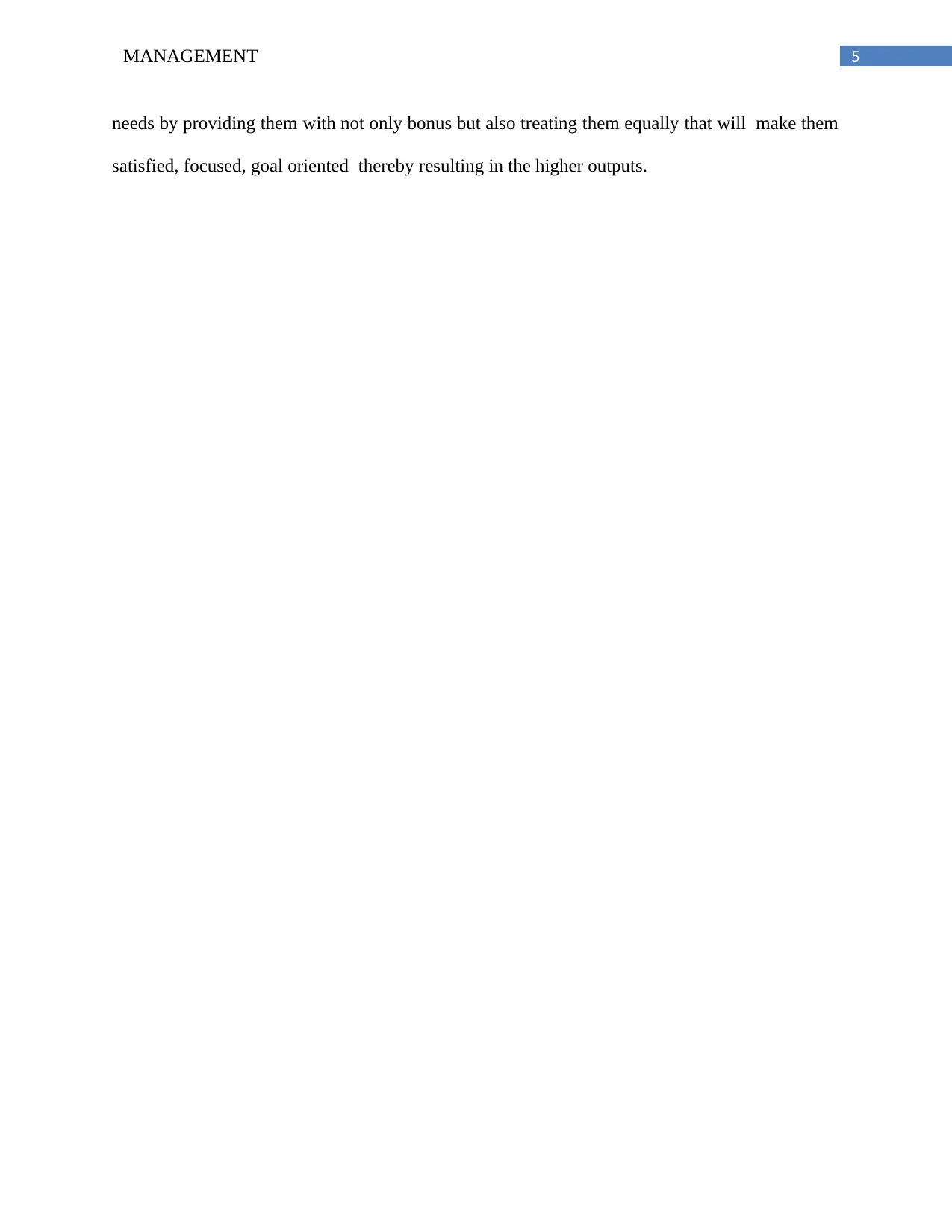
5MANAGEMENT
needs by providing them with not only bonus but also treating them equally that will make them
satisfied, focused, goal oriented thereby resulting in the higher outputs.
needs by providing them with not only bonus but also treating them equally that will make them
satisfied, focused, goal oriented thereby resulting in the higher outputs.
⊘ This is a preview!⊘
Do you want full access?
Subscribe today to unlock all pages.

Trusted by 1+ million students worldwide
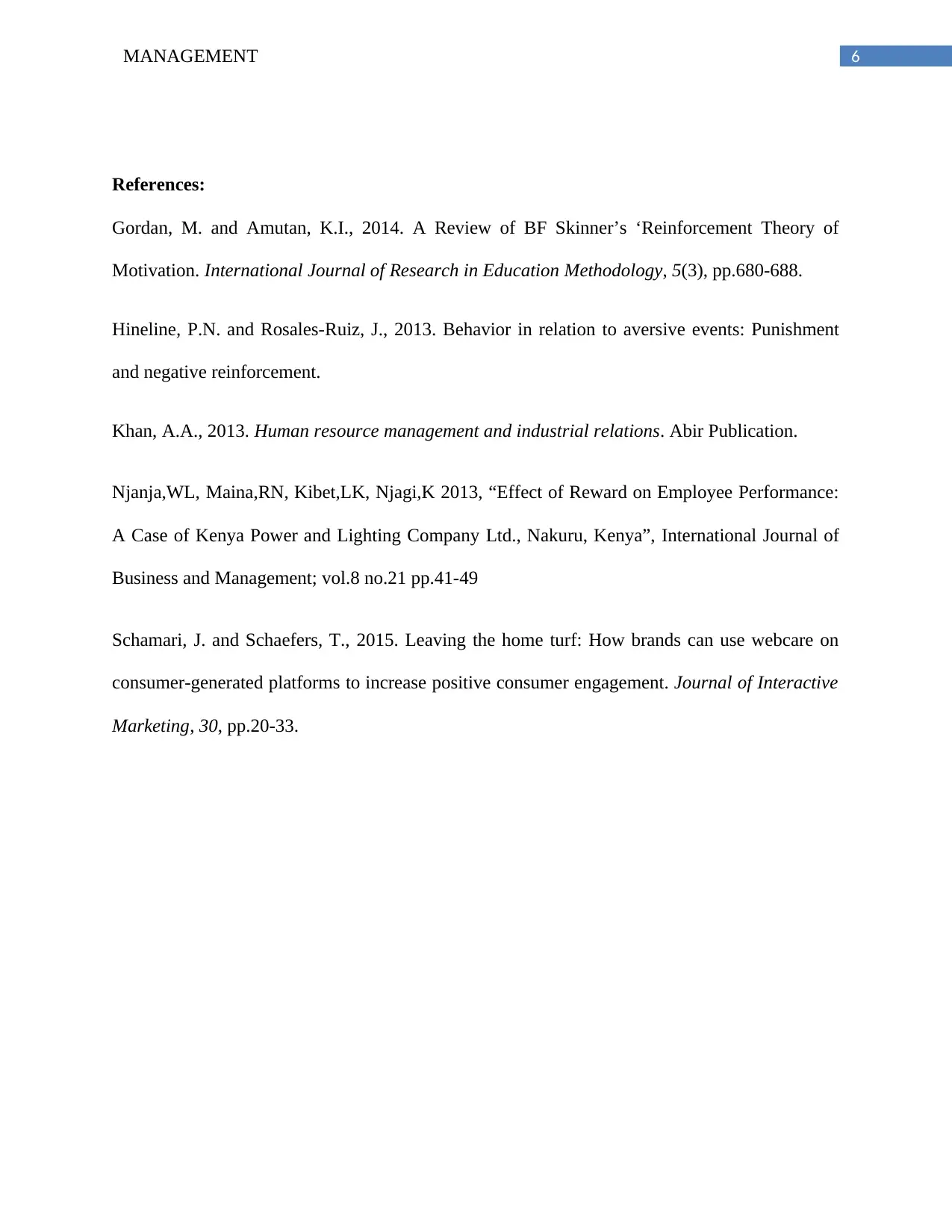
6MANAGEMENT
References:
Gordan, M. and Amutan, K.I., 2014. A Review of BF Skinner’s ‘Reinforcement Theory of
Motivation. International Journal of Research in Education Methodology, 5(3), pp.680-688.
Hineline, P.N. and Rosales-Ruiz, J., 2013. Behavior in relation to aversive events: Punishment
and negative reinforcement.
Khan, A.A., 2013. Human resource management and industrial relations. Abir Publication.
Njanja,WL, Maina,RN, Kibet,LK, Njagi,K 2013, “Effect of Reward on Employee Performance:
A Case of Kenya Power and Lighting Company Ltd., Nakuru, Kenya”, International Journal of
Business and Management; vol.8 no.21 pp.41-49
Schamari, J. and Schaefers, T., 2015. Leaving the home turf: How brands can use webcare on
consumer-generated platforms to increase positive consumer engagement. Journal of Interactive
Marketing, 30, pp.20-33.
References:
Gordan, M. and Amutan, K.I., 2014. A Review of BF Skinner’s ‘Reinforcement Theory of
Motivation. International Journal of Research in Education Methodology, 5(3), pp.680-688.
Hineline, P.N. and Rosales-Ruiz, J., 2013. Behavior in relation to aversive events: Punishment
and negative reinforcement.
Khan, A.A., 2013. Human resource management and industrial relations. Abir Publication.
Njanja,WL, Maina,RN, Kibet,LK, Njagi,K 2013, “Effect of Reward on Employee Performance:
A Case of Kenya Power and Lighting Company Ltd., Nakuru, Kenya”, International Journal of
Business and Management; vol.8 no.21 pp.41-49
Schamari, J. and Schaefers, T., 2015. Leaving the home turf: How brands can use webcare on
consumer-generated platforms to increase positive consumer engagement. Journal of Interactive
Marketing, 30, pp.20-33.
1 out of 7
Related Documents
Your All-in-One AI-Powered Toolkit for Academic Success.
+13062052269
info@desklib.com
Available 24*7 on WhatsApp / Email
![[object Object]](/_next/static/media/star-bottom.7253800d.svg)
Unlock your academic potential
Copyright © 2020–2025 A2Z Services. All Rights Reserved. Developed and managed by ZUCOL.





